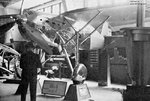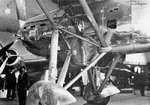Milos Sijacki
Senior Airman
The Ikarus IK-2 was a high-wing, all metal, single seat, monoplane fighter aircraft of indigenous design built for the Yugoslav Air Force. The IK-2 was designed by Kosta Sivčev and Ljubomir Ilić.
The prototype, designated the IK-L1, of the design was ordered from Ikarus A.D. in 1934, and was delivered for test in 1935. The aircraft was powered by a Hispano-Suiza 12Ycrs inline engine. The armament consisted of a 20 mm HS-404 cannon and two 7.92 mm Darne machine guns, both engine-mounted. The design was similar to the Polish PZL P.8, sharing its Pulawski wing (gull-wing) design, giving pilot an excellent view.
Captain Leonid Bajdak, a biplane advocate, tested the IK-1 in flight. During a full range of tests on the third flight the aircraft failed to pull out of a power dive and crashed. Bakdak bailed out and survived but claimed the IK-1 was not suitable as a fighter. Investigation of the wreckage disclosed that the failure was due to negligence in sewing a seam on one of the fabric covered wings, and therefore a decision was made to proceed with the second prototype, designated IK-2. The second prototype had metal skinned wings and was ready for test in June 1936. A new test pilot, Dobnikar, performed the preliminary flight tests, including a mock battle against a Hawker Fury, a biplane, flown by Captain Bajdak. The IK-2 outperformed the biplane in all respects.
Based upon these tests the Yugoslav Air Force ordered twelve IK-2 fighters, which were all delivered in 1937. In April 1941 when German forces invaded Yugoslavia, the only unit of Royal Yugoslav Air Force armed with this type of aircraft was 4th fighter regiment made out of 33rd and 34th air force groups stationed at Bosanski Aleksandrovac. 4th fighter regiment was armed with 18 Hawker Hurricanes and 8 Ikarus IK-2 fighter planes. On April the 7th, 5 IK-2 with 5 Hawker Hurricanes engaged German fighter planes in a dogfight during German attack on airport Rovine, base of Yugoslav 8th bomber regiment situated north of Banja Luka. During this brief encounter Yugoslav fighters managed to repel attack by 27 German fighters but suffer heavy losses. For the rest of the war IK-2 were used for strafing advancing German columns. At the end of the war all of the surviving IK-2 were handled to the air force of newly formed Independent State of Croatia.
A proposed development of the IK-2 was the IK-4, a two seat reconnaissance monoplane, but it was never ordered.
Variants:
* IK-1L : First prototype.
* IK-02 : Second prototype
* IK-2 : Single-seat fighter aircraft.
* IK-4 : Proposed two-seat reconnaissance aircraft. Not built.
The prototype, designated the IK-L1, of the design was ordered from Ikarus A.D. in 1934, and was delivered for test in 1935. The aircraft was powered by a Hispano-Suiza 12Ycrs inline engine. The armament consisted of a 20 mm HS-404 cannon and two 7.92 mm Darne machine guns, both engine-mounted. The design was similar to the Polish PZL P.8, sharing its Pulawski wing (gull-wing) design, giving pilot an excellent view.
Captain Leonid Bajdak, a biplane advocate, tested the IK-1 in flight. During a full range of tests on the third flight the aircraft failed to pull out of a power dive and crashed. Bakdak bailed out and survived but claimed the IK-1 was not suitable as a fighter. Investigation of the wreckage disclosed that the failure was due to negligence in sewing a seam on one of the fabric covered wings, and therefore a decision was made to proceed with the second prototype, designated IK-2. The second prototype had metal skinned wings and was ready for test in June 1936. A new test pilot, Dobnikar, performed the preliminary flight tests, including a mock battle against a Hawker Fury, a biplane, flown by Captain Bajdak. The IK-2 outperformed the biplane in all respects.
Based upon these tests the Yugoslav Air Force ordered twelve IK-2 fighters, which were all delivered in 1937. In April 1941 when German forces invaded Yugoslavia, the only unit of Royal Yugoslav Air Force armed with this type of aircraft was 4th fighter regiment made out of 33rd and 34th air force groups stationed at Bosanski Aleksandrovac. 4th fighter regiment was armed with 18 Hawker Hurricanes and 8 Ikarus IK-2 fighter planes. On April the 7th, 5 IK-2 with 5 Hawker Hurricanes engaged German fighter planes in a dogfight during German attack on airport Rovine, base of Yugoslav 8th bomber regiment situated north of Banja Luka. During this brief encounter Yugoslav fighters managed to repel attack by 27 German fighters but suffer heavy losses. For the rest of the war IK-2 were used for strafing advancing German columns. At the end of the war all of the surviving IK-2 were handled to the air force of newly formed Independent State of Croatia.
A proposed development of the IK-2 was the IK-4, a two seat reconnaissance monoplane, but it was never ordered.
Variants:
* IK-1L : First prototype.
* IK-02 : Second prototype
* IK-2 : Single-seat fighter aircraft.
* IK-4 : Proposed two-seat reconnaissance aircraft. Not built.







